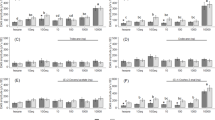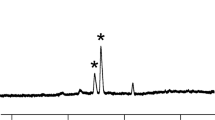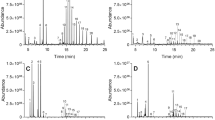Abstract
Adult Cosmopepla bimaculata discharge a volatile secretion from paired ventral metathoracic glands (MTG) when disturbed. Collected volatiles were similar in both sexes and consisted of n-tridecane (67%), (E)-2-decenal (12%), (E)-2-decenyl acetate (12%), (E)-2-hexenal (3%), hexyl acetate (2%), n-dodecane (2%), a tridecene isomer (1%), and n-undecane, n-tetradecane, and n-pentadecane (all <1%). In addition, undisturbed males produced a novel insect compound, (E)-8-heneicosene, whose function is unknown. The MTG secretion emerges as an enlarging droplet, which is held in place by a cuticular projection and a pleural scent area consisting of specialized rough cuticle surrounding the gland opening. Insects can selectively discharge from either the right or left gland or both glands simultaneously, can control the amount of fluid ejected, and can resorb the ejected secretion droplet back into the gland reservoir. In feeding trials, killdeer (Charadrius vociferous), starlings (Sturnus vulgaris), robins (Turdus migratorius), and anole lizards (Anolis carolinensis) rejected or demonstrated aversion to feeding on the bugs. Furthermore, bugs that lacked the secretion were more susceptible to predation than bugs with secretion, suggesting that the secretion functions in defense against predators.
Similar content being viewed by others
REFERENCES
Aldrich, J. R. 1988. Chemical ecology of the Heteroptera. Annu. Rev. Entomol. 33:211-238.
Aldrich, J. R. 1995. Chemical communication in the true bugs and parasitoid exploitation, pp. 318-363, in R. Cardé and W. Bell (eds.). Chemical Ecology of Insects 2. Chapman & Hall, New York.
Aldrich, J. R. 1996. Sex pheromones in Homoptera and Heteroptera, pp. 199-233, in C. W. Schaefer (ed.). Studies on Hemipteran Phylogeny. Entomology Society of America, Lanham, Maryland, 244 pp.
Aldrich, J. R., Numata, H., Borges, M., Bin, F., Waite, G. K., and Lusby, W. R. 1993. Artifacts and pheromone blends from Nezara spp. and other stink bugs (Heteroptera: Pentatomidae). Z. Naturforsch. 48c:73-79.
Bartelt, R. J. 1997. Calibration of a commercial solid-phase microextraction device for measuring headspace concentrations of organic volatiles. Anal. Chem. 69:364-372.
Bartelt, R. J., and Jackson, L. L. 1984. Hydrocarbon component of the Drosophila virilis (Diptera: Drosophilidae) aggregation pheromone: (Z)-10-Heneicosene. Ann. Entomol. Soc. Am. 77:364-371.
Bartelt, R. J., Schaner, A. M., and Jackson, L. L. 1986. Aggregation pheromones in five taxa of the Drosophila virilis species group. Physiol. Entomol. 11:367-376.
Bellas, T., and HÖlldobler, B. 1985. Constituents of mandibular and dufours glands of an Australian Polyrhachis weaver ant. J. Chem. Ecol. 11:525-538.
Blatchley, W. S. 1926. Heteroptera or True Bugs of Eastern North America with Especial Reference to the Faunas of Indiana and Florida. Nature Pub. Co., Indianapolis.
Blum, M. S. 1981. Chemical Defenses in Arthropods. Academic Press, New York.
Carlson, D. A., Roan, C., Yost, R. A., and Hector, J. 1989. Dimethyl disulfide derivatives of long chain alkenes, alkadienes, and alkatrienes for gas chromatography/mass spectrometry. Anal. Chem. 61:1565-1571.
Carrel, J. E. 1984. Defensive secretion of the pill millipede Glomeris marginata. I. Fluid production and storage. J. Chem. Ecol. 10:41-51.
Crewe, R. M., Blum, M. S., and Collingwood, C. A. 1972. Comparative analysis of alarm pheromones in the ant genus Crematogaster. Comp. Biochem. Physiol. 34B:703-716.
Decoursey, R. M., and Esselbaugh, C. O. 1962. Descriptions of the nymphal stages of some North American Pentatomidae (Hemiptera-Heteroptera). Ann. Entomol. Soc. Am. 55:323-342.
Eisner, T., Kristen, T., and Aneshansley, D. J. 1976. Defensive behavior of a termite (Nasutitermes exitiousus). Behav. Ecol. Sociobiol. 1:83-125.
Engen, S., JÄrvi, T., and Wiklund, C. 1986. The evolution of aposematic coloration by individual selection: A life-span survival model. Oikos 46:397-403.
Esselbaugh, C. O. 1946. A study of the eggs of the Pentatomidae (Hemiptera). Ann. Entomol. Soc. Am. 39:667-691.
Farine, J. P., Bonnard, O., Brossut, R., and Le Quere, J. L. 1992. Chemistry of pheromonal and defensive secretions in the nymphs and the adults of Dysdercus cingulatus Fabr. (Heteroptera, Pyrrhocoridae). J. Chem. Ecol. 18:65-76.
Farine, J. P., Everaerts, C., Le-Quere, J. L., Semon, E., Henry, R., and Brossut, R. 1997. The defensive secretion of Eurycotis floridana (Dictyoptera, Blattidae, Polyzosteriinae): Chemical identification and evidence of an alarm function. Insect Biochem. Mol. Biol. 27:577-586.
Fescemyer, H. W., and Mumma, R. O. 1983. Regeneration and biosynthesis of dytiscid defensive agents (Coleoptera: Dytiscidae). J. Chem. Ecol. 9:1449-1464.
Fish, J., and Alcock, J. 1973. The behavior of Chlorochroa ligata and Cosmopepla bimaculata (Thomas). Entomol. News 84:260-268.
Fisher, R. A. 1958. The Genetical Theory of Natural Selection, 2nd ed. Dover, New York.
Guilford, T. 1990. The evolution of aposematism, pp. 23-61, in D. L. Evans and J. O. Schmidt (eds.). Insect Defenses. State University of New York Press, Albany, New York.
Gunawardena, N. E., and Bandumathie, M. K. 1993. Defensive secretion of rice bug, Leptocorisa oratorius Fabricius (Hemiptera: Coreidae): A unique chemical combination and its toxic, repellent, and alarm properties. J. Chem. Ecol. 19:851-861.
Gunawardena, N. E., and Herath, H. M. W. K. B. 1991. Significance of medium chain n-alkanes as accompanying compounds in hemipteran defensive secretions: an investigation based on the defensive secretion of Coridius janus. J. Chem. Ecol. 17:2449-2458.
Gustavson, C. R. 1977. Comparative and field aspects of learned food aversions, pp. 23-43, in L. Barker, M. Best, and M. Domjan (eds.). Learning Mechanisms in Food Selection. Baylor University Press, Waco, Texas.
Harvey, P. H., and Greenwood, P. J. 1978. Anti-predator defence strategies: some evolutionary problems, pp. 129-151, in J. R. Krebs and N. B. Davies (eds.). Behavioural Ecology. Blackwell Scientific Publications, Oxford.
HÖfle, G., Steglich, W., and VorbrÜggen, H. 1978. 4-Dialkylaminopyridines as highly active acylation catalysts. Angew. Chem. Int. Ed. Engl. 17:569-583.
Kou, R., Tang, D. S., and Chow, Y. S. 1989. Alarm pheromone of pentatomid bug, Erthesina fullo Thunberg (Hemiptera: Pentatomidae). J. Chem. Ecol. 15:2695-2702.
Kuwahara, Y., Koshii, T., Okamoto, M., Matsumoto, K., and Suzuki, T. 1991. Chemical ecology on astigmatid mites: XXX. Neral as the alarm pheromone of Glycyphagus domesticus (De Geer) (Acarina: Glycyphagidae). Jpn. J. Sanit. Zool. 42:29-32.
Leal, W. S., Panizzi, A. R., and Niva, C. C. 1994. Alarm pheromone system of leaf-footed bug Leptoglossus zonatus (Heteroptera: Coreidae). J. Chem. Ecol. 20:1209-1216.
McBrien, H. L., and Millar, J. G. 1999. Pheromones of phytophagous true bugs, pp. 277-304, in A. K. Minks and J. Hardie (eds.). Pheromones of Non-lepidopteran Insect Pests of Agriculture. CAB International, Wallingford, England.
McPherson, J. E. 1976. Notes on the biology of Cosmopepla bimaculata (Hemiptera: Pentatomidae) in Southern Illinois. Trans. Ill. State Acad. Sci. 69:362-366.
Millar, J. G., and Rice, R. E. 1998. Sex pheromone of the plant bug Phytocoris californicus (Heteroptera: Miridae). J. Econ. Entomol. 91:132-137.
Millar, J. G., Rice, R. E., and Wang, Q. 1997. Sex pheromone of the mirid bug Phytocoris relativus. J. Chem. Ecol. 23:1743-1754.
Nagnan, P., Cassier, P., Andre, M., Llosa, J. F., and Guillaumin, D. 1994. Fine structure and physicochemical analysis of the metathoracic scent glands of Lincus malevolus (Rolston) and L. spurcus (Rolston) (Heteroptera Pentatomidae). Int. J. Insect Morphol. Embryol. 23:355-370.
Pasteels, J. M., GrÉgoire, J.-C., and Rowell-Rahier, M. 1983. The chemical ecology of defense in arthropods. Annu. Rev. Entomol. 28:263-289.
Pasteels, J. M., Rowell-Rahier, M., Braekman, J. C., and Daloze, D. 1984. Chemical defences in leaf beetles and their larvae: The ecological, evolutionary and taxonomic significance. Biochem. Syst. Ecol. 12:395-406.
Peschke, K., and Metzler, M. 1986. Cuticular hydrocarbons and female sex pheromones of the rove beetle, Aleochara curtula (Coleoptera: Staphylinidae). Insect Biochem. 17:167-178.
Severson, R. F., Rogers, C. E., Marti, O. G., Gueldner, R. C., and Arrendale, R. F. 1991. Ventral eversible gland volatiles from larvae of the fall armyworm, Spodoptera frugiperda (J. E. Smith) (Lepidoptera: Noctuidae). Agric. Biol. Chem. 55:2527-2530.
SillÉn-Tullberg, B., and E. H. Bryant. 1983. The evolution of aposematic coloration in distasteful prey: An individual selection model. Evolution 37:993-1000.
Sosa-Gomez, D. R., Boucias, D. G., and Nation, J. L. 1997. Attachment of Metarhizium anisopliae to the southern green stink bug Nezara viridula cuticle and fungistatic effect of cuticular lipids and aldehydes. J. Invert. Pathol. 69:31-39.
Staddon, B. W. 1979. The scent glands of Heteroptera. Adv. Insect Physiol. 14:351-418.
Staddon, B. W., Thorne, M. J., and Knight, D. W. 1987. The scent glands and their chemicals in the aposematic cotton harlequin bug. Tectocoris diopthalmus (Heteroptera: Scutelleridae). Aust. J. Zool. 35:227-234.
Surender, P., Janaiah, C., Reddy, V. K., and Reddy, S. M. 1987. Antifungal activity of secretions of scent glands from heteropteran bugs. Indian J. Exp. Biol. 25:233-234.
Suzuki, T., Haga, K., Leal, W. S., Kodama, S., and Kuwahara, Y. 1989. Secretion of thrips: IV. Identification of beta-acaridial from three gall-forming thrips (Thysanoptera: Phlaeothripidae). Appl. Entomol. Zool. 24:222-228.
Tschinkel, W. R. 1975. A comparative study of the chemical defensive system of tenebrionid beetles: chemistry of the secretions. J. Insect Physiol. 21:753-783.
Vulinec, K. 1990. Collective security: aggregation by insects as a defense, pp. 251-288, in D. L. Evans and J. O. Schmidt (eds.). Insect Defenses: Adaptive Mechanisms and Strategies of Prey and Predators. State University of New York Press, Albany, New York.
Wallace, J. B., and Blum, M. S. 1969. Refined defense mechanisms in Chrysomela scripta. Ann. Entomol. Soc. Am. 62:503-506.
Wallbank, B. E., and Waterhouse, D. F. 1970. The defensive secretions of Polyzosteria and related cockroaches. J. Insect Physiol. 16:2081-2096.
Whitman, D. W. 1988. Allelochemical interactions among plants, herbivores, and their predators, pp. 11-64, in P. Barbosa and D. K. Letourneau (eds.). Novel Aspects of Insect-Plant Interactions. John Wiley, New York.
Whitman, D. W., Blum, M. S., and Alsop, D. W. 1990. Allomones: chemicals for defense, pp. 289-351, in D. L. Evans and J. O. Schmidt (eds.). Insect Defenses: Adaptive Mechanisms and Strategies of Prey and Predators. State University of New York Press, Albany, New York.
Whitman, D. W., Billen, J. P., Alsop, D., and Blum, M. S. 1991. Anatomy, ultrastructure, and functional morphology of the metathoracic tracheal defensive glands of the grasshopper Romalea guttata. Can. J. Zool. 69:2100-2108.
Whitman, D. W., Jones, C. G., and Blum, M. S. 1992. Defensive secretion production in lubber grasshoppers (Orthoptera: Romaleidae): Influence of age, sex, diet, and discharge frequency. Ann. Entomol. Soc. Am. 85:96-102.
Wiklund, C., and JÄrvi, T. 1982. Survival of distasteful insects after being attacked by naive birds: a reappraisal of the theory of aposematic coloration evolving through individual selection. Evolution 36:998-1002.
Author information
Authors and Affiliations
Rights and permissions
About this article
Cite this article
Krall, B.S., Bartelt, R.J., Lewis, C.J. et al. Chemical Defense in the Stink Bug Cosmopepla bimaculata . J Chem Ecol 25, 2477–2494 (1999). https://doi.org/10.1023/A:1020822107806
Issue Date:
DOI: https://doi.org/10.1023/A:1020822107806




